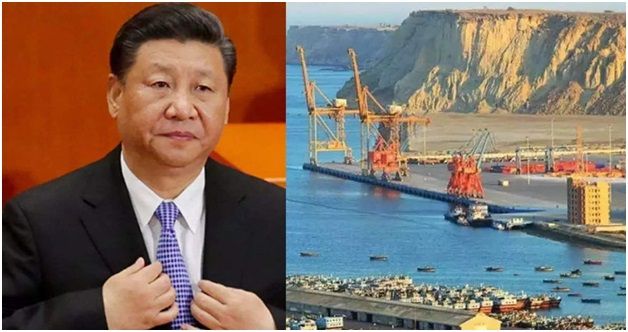China Rejects Expanding CPEC Cooperation in Energy, Water, and Climate with Pakistan (The Hindu)

- 29 Sep 2023
Why is it in the News?
China has refused to further expand cooperation in the areas of energy, water management, and climate change under the multi-billion dollar China-Pakistan Economic Corridor (CPEC), it emerged on September 25, signalling a strain in the 'ironclad' friendship between the two all-weather allies.
Summary of News: Challenges Arise as China Rejects Pakistan's CPEC Expansion Proposals:
- In a significant development, Beijing has declined multiple investment proposals from Islamabad, spanning various sectors like energy, tourism, water management, and climate change, all within the ambit of the China-Pakistan Economic Corridor (CPEC).
- These decisions were revealed through the minutes of the 11th Joint Cooperation Committee (JCC) meeting, where the future of CPEC projects is discussed.
- The JCC serves as a pivotal decision-making body for CPEC matters.
- China's reluctance to expand cooperation in these specific areas within the CPEC framework highlights the current challenges faced by both nations in their efforts to further strengthen their economic partnership.
What is CPEC?
- CPEC, short for the China-Pakistan Economic Corridor, is a vast network of infrastructure projects spanning 3,000 kilometers.
- It connects China's northwest Xinjiang Uygur Autonomous Region to the Gwadar Port in Pakistan's western province of Balochistan.
- This initiative represents a bilateral partnership between Pakistan and China, designed to enhance connectivity within Pakistan through the development of highways, railways, pipelines, as well as energy and industrial infrastructure projects.
- The primary objective of CPEC is to enable China to establish access to the Middle East and Africa via the Gwadar Port, providing a strategic link to the Indian Ocean.
- In return, China actively supports various development projects in Pakistan, addressing the country's energy shortages and assisting in stabilizing its economic situation.
- It's important to note that CPEC is an integral part of the broader Belt and Road Initiative (BRI), initiated in 2013.
- The BRI aims to create an extensive network of land and sea routes connecting Southeast Asia, Central Asia, the Gulf region, Africa, and Europe, fostering international economic cooperation and development.
What are the Implications of CPEC for India?
- Challenges to Sovereignty: India has consistently voiced opposition to the CPEC project because it passes through the Pakistan-occupied Kashmir territory of Gilgit-Baltistan, a disputed region claimed by both India and Pakistan.
- The corridor is also perceived as a potential alternative economic route for the Indian-administered Kashmir Valley.
- Regional Optimism: Despite India's official stance, key stakeholders in the Indian state of Jammu and Kashmir have expressed optimism about the potential benefits of the CPEC project.
- Some local business and political leaders have even proposed declaring both sides of the Line of Control (LoC) in Kashmir as a 'Special Economic Zone.'
- Territorial Implications: The success of CPEC could bolster Gilgit-Baltistan's international recognition as part of Pakistani territory, undermining India's claim over this region, which spans 73,000 square kilometers and is home to over 1.8 million people.
- China's Maritime Influence: Once fully operational, CPEC could offer China a more efficient trade route to major U.S. ports on the East Coast, potentially reshaping international trade dynamics.
- This could grant China greater influence over global goods movement between the Atlantic and Pacific oceans.
- China's 'String of Pearls': CPEC aligns with China's broader strategy of expanding its presence in the Indian Ocean, often referred to as the 'String of Pearls.'
- This involves establishing a network of airfields and ports in countries surrounding India.
- Gwadar port's control would solidify China's dominance in the Indian Ocean region.
- Pakistan's Economic Boost: CPEC has the potential to accelerate Pakistan's economic development.
- With easier access to Chinese raw materials, Pakistan's textile and construction material industries could become regional leaders, potentially impacting Indian exports in similar sectors.
- Strengthening BRI and Chinese Influence: CPEC is a significant component of China's Belt and Road Initiative (BRI), aimed at enhancing trade connectivity with Eurasia.
- A more integrated China in the global economy may challenge India's aspirations for a permanent seat on the UN Security Council.
Way forward
- India has the opportunity to capitalize on its strategic positioning by collaborating with like-minded nations and actively engaging in multilateral endeavors such as:
- Asia-Africa Growth Corridor: This India-Japan economic cooperation agreement holds significant promise for India's strategic interests and serves as a potential counterbalance to China's influence.
- Blue Dot Network: Championed by the United States, the Blue Dot Network is a multi-stakeholder initiative that unites governments, the private sector, and civil society in the pursuit of establishing high-quality, trustworthy standards for global infrastructure development.
- It is poised to become a globally recognized system for evaluating and certifying infrastructure projects, particularly in the Indo-Pacific region.
